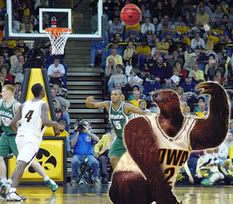 People probably don't generally think of Iowa as their first destination for bone and fossil-hunting. And sloth bones don't exactly get the press coverage that a giant T. rex or a novel dinosaur species often receive. But this is still a fascinating story:
People probably don't generally think of Iowa as their first destination for bone and fossil-hunting. And sloth bones don't exactly get the press coverage that a giant T. rex or a novel dinosaur species often receive. But this is still a fascinating story:
After three years of digging up bones in an Iowa creek near Shenandoah, University of Iowa researchers and others found 31 bones of an extinct giant sloth.The team found the bones of the juvenile giant sloth just 10 feet away from where adult sloth bones were discovered in 2001.
"We're almost certain that we are looking at a mother and an infant," said David Brenzel, curator of the UI Museum of Natural History.
***
Brenzel said the research team found only a small fraction of about 200 bones of the infant sloth, but it will give researchers a good idea of the size of the baby sloth. He said they have most of the torso bones; he estimates the infant sloth weighed about 200 to 250 pounds.
Although other sites have previously produced bits and pieces of juvenile sloths, there has never been a direct association with an adult, Brenzel said, adding that the bones of the two sloths were found in the same clay layer of the creek, only 10 feet away from each other, making it more likely they were related.
However, Brenzel said the museum will do a number of DNA tests to positively mark the two as family.
Sloths are estimated to have gone extinct about 11,000 to 12,000 years ago. They most likely were vegetarians, weighing up to 5,000 to 6,000 pounds and standing nine to 10 feet tall, Brenzel said.
A photo album of the current dig can be found here.
As mentioned, a previous dig had already uncovered an adult giant sloth. At the U of Iowa Museum of Natural History, they have a recreation of the sloth (nicknamed "Rusty"), and he's quite the star. (And, apparently, quite the fashionista as well). If you're one who leans toward more ancient history, we also have the Devonian fossil gorge, exposed by a flood in 1993:
For 28 days as much as 17,000 cubic feet of water-per-second flowed down the spillway, obliterating the road and the campground at the end. Fifteen feet of unconsolidated river-bottom silt and sand were rapidly eroded, exposing the Middle Devonian Cedar Valley Group limestones below. Up to five feet of limestone was then eroded near the end of the spillway and blocks weighing as much as two or three tons were carried hundreds of feet downstream.
When the flood abated, the eroded gorge surface revealed a succession of 375 million year-old bedding planes with diverse and abundant fossils commonly standing out in relief. The Devonian Fossil Gorge soon emerged as the name for the future. When first admitted to the gorge site, over the Labor Day weekend of 1993, 16,000 visitors were counted entering from one of the two available entrances. Since then, there have been more than three quarters of a million visitors, commonly combing the Gorge visit with those of related adjacent exhibits at the Coralville Dam Visitor Center and the Museum of Natural History's Iowa Hall exhibit on the University of Iowa campus.
It's not all just corn and hogs here.
Image from http://www.iowalum.com/magazine/feb03/images/slothfinal.jpg

I got to thinking...
What if the Devonian layer got exposed a few thousand years back. Along comes a wandering giant sloth, who tumbles into the exposed gully, and kills himself by landing on his head. A bit later a smilodon scavenges the remains, and goes so far as to crush the fossil of a Devonian fish. Over the course of time the scene is covered over again, then re-exposed in our time. Think of all the fun we'd have with that.
Tara - I like the picture of the Iowa basketball player. Maybe NU can kick some Iowa butt this year, as the sloth is not known for it's speed, and I would guess it's foul shooting is abysmall, and almost Shaquille-like.
On the other hand, I want the sloth to do well, so that scientists will be prompted by a huge public outcry to clone the things, because they look so cool!
Also, I didn't know about the wash, and now I do, and it looks like it is worth a visit, so thanks!